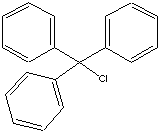PRODUCT IDENTIFICATION

H.S. CODE
TOXICITY
Trityl Chloride; Triphenylmethyl chloride;
SMILES
C(c1ccccc1)(c1ccccc1)(c1ccccc1)Cl
CLASSIFICATION
Protecting and Derivatizing reagent. Tritylation agent
PHYSICAL AND CHEMICAL PROPERTIES
310 C
9.6
REFRACTIVE INDEX
NFPA RATINGS
AUTOIGNITION
FLASH POINT
GENERAL DESCRIPTION & EXTERNAL LINKS
Wikipedia Linking: http://en.wikipedia.org/wiki/Trityl_chloride
http://www.sigmaaldrich.com/
One
of the common difficulties with natural product and other multi-step
syntheses is the need to render one functional group inert to a
particular reagent while keeping another group open for further
chemical elaboration. Despite the great advances made in the involved
syntheses of multifunctional products, selectivity in functional
group transformations remains a critical issue in organic synthesis.
Unfortunately for the synthetic chemist, there is no perfect protecting
group applicable to any functional group in any situation. Thus,
the need exists for the synthetic chemist to have a handy toolbox
of selective and efficient protecting groups that can be applied
and easily removed under a variety of conditions....
F-Trityl
Alcohol and Chlorides:Several fluorous versions of trityl protecting
groups are available from Sigma-Aldrich for the protection of alcohols,
amines and carboxylates. These include F-Trt, F-MMT, and F-DMT that
are analogous to the conventional trityl, monomethoxy trityl, and
dimethoxy trityl groups and react analogously to their non-fluorous
counterpart. Each of these groups is acid labile with the relative
rate of deprotection being F-Trt < F-MMT < F-DMT. The F-DMT
group has recently been used in oligonucleotide synthesis followed
by purification through F-SPE.
http://journals.tubitak.gov.tr/
N-triphenylmethyl
and N-4,4'-dimethoxytriphenylmethyl of o-aminophenol, m-aminophenol,
and paminophenol compounds were easily prepared from triphenylmethyl
chloride and 4,4'-dimethoxytriphenylmethyl chloride. S-triphenylmethyl-2-mercapto
ethanol was also selectively synthesized using the triphenylmethyl
chloride and 2-mercapto ethanol. The reactivity of nitrogen and
sulfur versus oxygen in the protection reactions was compared. In
principle, the protection of aminophenols and 2-mercapto ethanol
with triarylmethyls (trityls) may take place on the oxygen. However,
in this framework, we discuss the di erent reactivities of oxygen,
nitrogen and sulfur towards triphenylmethyl chloride (TrCl) and
4,4'-dimethoxytriphenylmethyl chloride (DMTrCl) and nd that
nitrogen and sulfur are more reactive than oxygen......
APPEARANCE
CONTENT
97.5% min
MELTING POINT
0.5% max
0.2% max